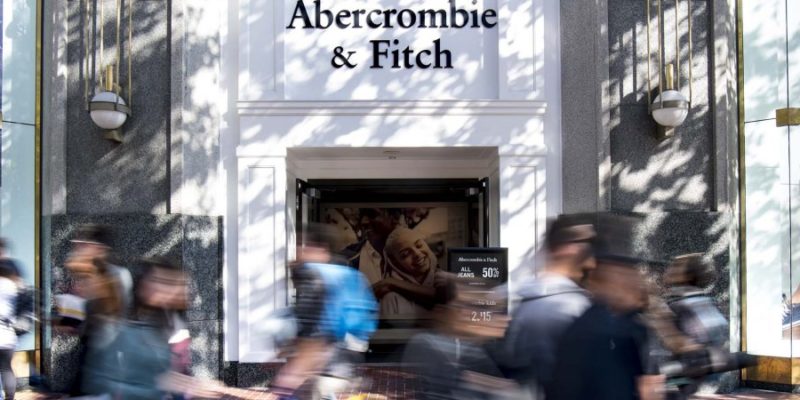The rise, fall, and rebirth of Abercrombie & Fitch is an arc that doubles as a business case study in management practices and brand reinvention.
Abercrombie & Fitch was a darling American brand that dominated the closets of teens and young adults in the late nineties and early aughts, only to implode spectacularly. The brand reveled in its WASPiness: it marketed the All-American look through exclusivity, plastering images of shredded physiques across storefronts and shopping bags–all while hiring people who sported the same look.
At one point, shirtless men (with washboard abs, of course) were positioned at storefronts to welcome patrons. The company sold sex in a palatable way: wearing Abercrombie was a status symbol, which made it excusable for the brand to dominate high school hallways.
This was all done under the direction of former Abercrombie CEO Mike Jeffries, the man responsible for giving the Abercrombie look a facelift. Founded in 1892, Abercrombie historically catered toward sportsmen and mostly sold outdoor and sporting goods. At one point, the brand even called Teddy Roosevelt and Ernest Hemingway customers. But when Jeffries assumed the role of CEO in 1992, he honed the brand’s strategy on elitism and brought on others to help bring his vision to life.
Part of the brand’s appeal is that it was both exclusive and aspirational: teenagers and college customers yearned to be part of the cool kid club, explains Dustin York, an associate professor of communication at Maryville University. “They don’t want to stand out from the crowd necessarily,” he says. “But they still want to be seen as a popular and successful high school or college students”
“Abercrombie really almost took that philosophy and basically put it on steroids,” York adds.
But the momentum behind Abercrombie was overcome by other cultural forces as consumer preferences shifted and critics stood up to what appeared to be a blatantly racist and discriminatory ideology that propped up the brand. Amid growing criticism, Abercrombie flamed out, as recently portrayed in the new Netflix documentary White Hot: The Rise and Fall of Abercrombie & Fitch.
Now operating under the leadership of Fran Horowitz, Abercrombie has changed its tune. The monocultural monotony that the brand once embraced has been replaced online by a presence that imbues inclusivity. Its website and social media feature models of different races and sizes, accompanied by celebratory posts about community and acceptance.
Abercrombie certainly isn’t the first fashion brand to flame out, but its quick fall offers some lessons worth remembering:
Change is essential for survival
Change may be uncomfortable, but it’s essential for companies that want to stay relevant. The good news is that companies that are weaker with ideation can always source that skill elsewhere. But ideation is imperative to longevity, especially amid a changing environment of consumer preferences. “If you don’t like change, you’ll like being irrelevant even less,” says York.
How You Treat Employees Has Long-Term Implications
The hiring practices of Abercrombie were rooted in racism, elitism, and discrimination, according to the documentary. Recruiters operated under instructions to hire only good-looking people, which Abercrombie defined in a booklet that spelled out what was acceptable. While “classic hairstyles” presented on a white model were in the acceptable category, dreadlocks on a Black model fell into the unacceptable category.
Ultimately, how Abercrombie treated its employees and job candidates ultimately unraveled the fabric of its strong brand, says Kathy Gersch, a former Nordstrom vice president who is the chief commercial officer at Kotter, a business consulting firm.
Abercrombie was hit with multiple lawsuits over its discriminatory practices. A lawsuit filed in 2003 alleged discrimination against Asian, Black and Hispanic employees. Abercrombie shied away from hiring non-white individuals to work on the sales floor and when it did, encouraged non-white employees to work other roles in the store that didn’t interact with the public, according to the suit. The company eventually agreed to a $40 million settlement and a consent decree requiring it to implement diversity and inclusion measures in the business.
The company also lost a religious discrimination case filed by Samantha Elauf, a Muslim woman who claimed she wasn’t hired by the brand because she wore a hijab. The Supreme Court eventually ruled in Elauf’s favor in 2015 and found that Abercrombie violated civil rights law.
Think customer-first
One of the critical components behind Abercrombie’s downfall was its intense focus on the brand, rather than the customers. Businesses that see quick growth as a result of cultural forces need to remember to keep their customers in mind, according to Carlos Castelán, the managing director of The Navio Group, a retail management consulting firm. Castelán cautions that businesses shouldn’t get too far over their skis when they’re scaling their company. “Businesses that lose sight of their customer and believe the brand itself is what’s most powerful often erode over time,” he explains. “Thinking customer-first rather than assuming the infallibility of the brand is the key lesson learned from the rise and fall of Abercrombie.”
Brands help shape culture and society
Brands are important to society because they help people express themselves, but also can foster a sense of community and social belonging. Take cult classics like Trader Joe’s or Apple, both of which have devoted customer bases that continue to subscribe to new products the companies pump out. Apple, in its own way, influences current discourse (the prevalence of iMessage has led to lighthearted jabs around green text bubbles sent from non-Apple devices.) Whatever brand people choose to wear acts like a billboard that shows who they are as a person and what values they have, according to York.
“Brands have the most impact in society: more than legislation, more than any president, more than any single influencer,” says York. “Large brands can move the needle on any topic.” But, as in Abercrombie’s case, not always in the right way.











Comments